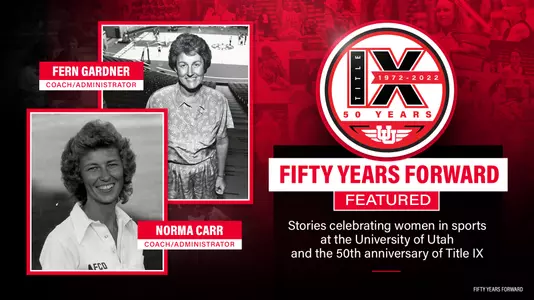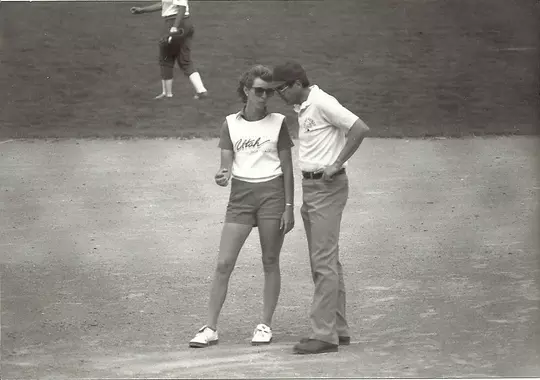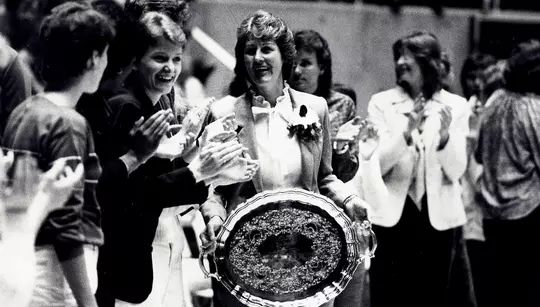Completed Event: General versus Arizona on January 18, 2002

General

6/28/2022 11:00 AM | General, Softball, Women's Basketball, Volleyball
The two administrators and coaches wore many hats as they helped get Utah women’s athletics off the ground.
Second In A Series
By Dirk Facer
Fern Gardner and Norma Carr didn’t exactly paint the town red. Well, at least not all of it.
As women’s athletics began to grow at the University of Utah in the mid-1970s, the duo bought some brushes and paint and went to work on a new locker room for women’s intercollegiate athletics.
The tight space, located in the East HPER building, had some small lockers in it from the room’s previous use as a sauna for male coaches. They were soon replaced with some larger football lockers that had seen better days.
Installation wasn’t enough, though.
Gardner and Carr, who served as both administrators and coaches at the time, had additional plans.
“We wanted it to look like a Ute locker room. So we painted the fronts and sides of the lockers red,” Carr recalled. “There were some spills, you know, where it went through the grill areas and would drip down on the inside. But, for the most part, the women athletes were excited—above and beyond—to have these full lockers that were painted red.”
Carr added that the transformation was pretty amazing, even if the room (configured to also house an equipment room, showers and restroom stalls) was shared by a majority of the women’s programs. It was quite crowded at times. Even so, it was a place to call home—an early headquarters for a growing program.
“We were pretty proud and we were happy, obviously, at the reaction of the athletes,” Carr said.

In the wake of Title IX being signed into law, there were plenty of ups and downs that followed for women’s athletics. Battles included ignorance. That was something Gardner learned first-hand at a Utah football game she attended in 1975 when the Utes went 1-10.
In the midst of the action, Gardner heard a drunken man behind her share his opinion on the topic to all within earshot.
“He’s yelling, ‘If it wasn’t for that f----ing Title IX taking money away from football, we would be decent,’” remembered Gardner. “That was the worst thing I had ever heard.”
Gardner was pretty sure the guy didn’t know who she was and didn’t say it intentionally. However, it underscored the fact that there were a lot of misunderstandings about Title IX at the time.
Cooperation was sought on several fronts. Pushing Title IX wasn’t necessarily on Gardner’s agenda in addressing the growing needs.
“I just wanted to be able to relate to the staff and do it right so I didn’t burn any bridges,” Gardner said. “And I’m sure I was slow for some of my coaches. But I wasn’t one who wanted to go in and take money from somebody else to have a program.”
After a successful career at Utah State, Gardner was hired to coach basketball and oversee women’s athletics at Utah. The latter was something she did under various titles through 1996, replacing Janet Thurgood shortly after arriving.
I just wanted to be able to relate to the staff and do it right so I didn’t burn any bridges. I wasn’t one who wanted to go in and take money from somebody else to have a program.Fern Gardner
Gardner noted that Title IX was never mentioned to her by any administrators at Utah. Even so, she said the opportunities for women in athletics grew and the university tried to do things the right way. Even so, the pace was set by the availability of funding.
“The interest was there, definitely,” Gardner said. “I think the biggest thing to start with when I took my job was better facilities, some kind of common ground with facilities. I think that was the hardest thing.”
Utah women’s basketball used to play its games at a gym in the HPER building before moving to the Special Events Center (now Jon M. Huntsman Center). Gardner recalls gymnastics calling a tiny gym on the west side of HPER home. It was quickly filled up with equipment and gymnasts, and the fans came around quickly as well. Gardner recalled she could barely get in the door at one of the meets in the early days of the program.
“It was like, ‘Oh, my gosh.’ It didn’t take us long to get out of there for gymnastics,” said Gardner, who noted how fast the program blossomed. She added that it was crazy, noting her respect for Greg Marsden and all the work he did to make it happen.
Softball also had its challenges. The Utes had to travel out to the Cottonwood Complex for practices and games. Although it proved to be a scheduling nightmare, Salt Lake County authorities worked with them on that. Now there’s an on-campus facility for softball, just as there are the other women’s programs.
“We tried to do the right thing and that was our goal,” said Dr. Chris Hill about the growth of women’s programs during his 31-year tenure at Utah’s athletics director. “I think our culture was that it’s important and it’s valued.”

Hill, who retired in 2018, has similar thoughts about Gardner. He said her strength and knowledge of women’s sports got his attention right away.
“There’s still a lot to be done,” Hill said. “But the positive side of women’s athletics is just fabulous. That’s why it needs to grow more and more.”
Pioneers like Gardner forged the way at Utah. Her leadership was appreciated.
“Fern was really, really good at helping solve problems, not just talking about problems,” Hill said. “There’s a big difference. She appreciated my approach, but was also strong enough to provide solutions, or at least say, ‘Where do we need to be?’ and be a team player. That’s a fine line because sometimes you have to listen to people say bad things about women’s athletics and it can really drive you crazy.”
Gardner, he continued, helped Utah athletics get better every year.
The upward trajectory is pleasing to those who helped make it happen. However, there’s not a complete sense of satisfaction.
“We didn’t even have trophy cases for a long time where we could put things,” said Carr, who coached volleyball and softball and helped with Gardner with basketball and administrative duties. “Everything just evolved. There was progress being made. It just was slow.”
Fern was really, really good at helping solve problems, not just talking about problems. There's a big difference.Former Athletics Director Dr. Chris Hill
Since those days, the facilities have changed and student-athletes are being provided with more and more support, both on the field of play and in the areas of personal development. Nutritional programs, mental health guidance, and career development through programs like the Ute Academy are now available to them.
Five years ago, Utes with Wings was formed by Utah Athletics as a way for supporters to provide funding directly to women’s programs for team building exercises and retreats, foreign and domestic travel, facility enhancement and overall program development. The program has been embraced by the community, with financial support coming from numerous donors, including America First Credit Union, which has donated $100,000 annually to Utes with Wings.
And to think it all may have started with a paint job by the bosses back in the day.
“We were excited,” Carr recalled. “We finally had big lockers and a place for the athletes, and that was such a big deal then. But it is awesome to see where things are going.”